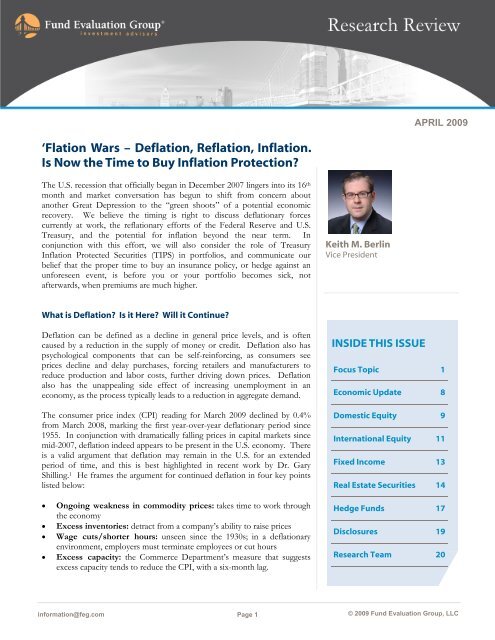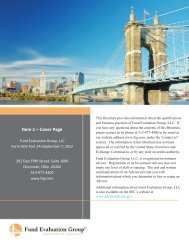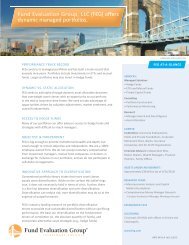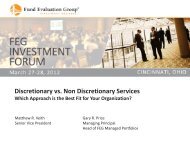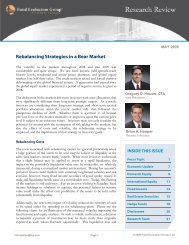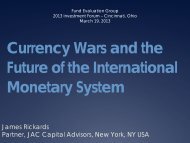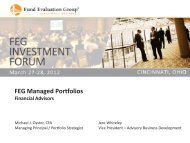download pdf - Fund Evaluation Group, LLC
download pdf - Fund Evaluation Group, LLC
download pdf - Fund Evaluation Group, LLC
You also want an ePaper? Increase the reach of your titles
YUMPU automatically turns print PDFs into web optimized ePapers that Google loves.
‘Flation Wars – Deflation, Reflation, Inflation.<br />
Is Now the Time to Buy Inflation Protection?<br />
The U.S. recession that officially began in December 2007 lingers into its 16 th<br />
month and market conversation has begun to shift from concern about<br />
another Great Depression to the “green shoots” of a potential economic<br />
recovery. We believe the timing is right to discuss deflationary forces<br />
currently at work, the reflationary efforts of the Federal Reserve and U.S.<br />
Treasury, and the potential for inflation beyond the near term. In<br />
conjunction with this effort, we will also consider the role of Treasury<br />
Inflation Protected Securities (TIPS) in portfolios, and communicate our<br />
belief that the proper time to buy an insurance policy, or hedge against an<br />
unforeseen event, is before you or your portfolio becomes sick, not<br />
afterwards, when premiums are much higher.<br />
What is Deflation? Is it Here? Will it Continue?<br />
Deflation can be defined as a decline in general price levels, and is often<br />
caused by a reduction in the supply of money or credit. Deflation also has<br />
psychological components that can be self-reinforcing, as consumers see<br />
prices decline and delay purchases, forcing retailers and manufacturers to<br />
reduce production and labor costs, further driving down prices. Deflation<br />
also has the unappealing side effect of increasing unemployment in an<br />
economy, as the process typically leads to a reduction in aggregate demand.<br />
The consumer price index (CPI) reading for March 2009 declined by 0.4%<br />
from March 2008, marking the first year-over-year deflationary period since<br />
1955. In conjunction with dramatically falling prices in capital markets since<br />
mid-2007, deflation indeed appears to be present in the U.S. economy. There<br />
is a valid argument that deflation may remain in the U.S. for an extended<br />
period of time, and this is best highlighted in recent work by Dr. Gary<br />
Shilling. 1 He frames the argument for continued deflation in four key points<br />
listed below:<br />
• Ongoing weakness in commodity prices: takes time to work through<br />
the economy<br />
• Excess inventories: detract from a company’s ability to raise prices<br />
• Wage cuts/shorter hours: unseen since the 1930s; in a deflationary<br />
environment, employers must terminate employees or cut hours<br />
• Excess capacity: the Commerce Department’s measure that suggests<br />
excess capacity tends to reduce the CPI, with a six-month lag.<br />
information@feg.com<br />
Page 1<br />
Keith M. Berlin<br />
Vice President<br />
INSIDE THIS ISSUE<br />
APRIL 2009<br />
Focus Topic 1<br />
Economic Update 8<br />
Domestic Equity 9<br />
International Equity 11<br />
Fixed Income 13<br />
Real Estate Securities 14<br />
Hedge <strong>Fund</strong>s 17<br />
Disclosures 19<br />
Research Team 20<br />
© 2009 <strong>Fund</strong> <strong>Evaluation</strong> <strong>Group</strong>, <strong>LLC</strong>
information@feg.com<br />
Page 2<br />
APRIL 2009<br />
Providing additional firepower to the potential for a lengthy bout of deflation is the de-leveraging of the U.S. consumer.<br />
Savings rates declined from a robust 12% in the early 1980s, to a negative savings rate in the third quarter of 2005.<br />
More recently amid the lengthening recession, personal savings reached 4.1% in the first quarter of 2009, as shown in<br />
the following chart. 2 With personal savings rates climbing, the unemployment rate rising, and the inability of<br />
corporations to re-lever their balance sheets, the prolonged deflationary argument and the possibility of a lengthier<br />
recession than many investors anticipate holds merit. On a more positive note, economist Hyman Minsky, in his book<br />
Stabilizing an Unstable Economy, noted that high personal savings rates built up during recessions ultimately lead the<br />
consumer to be seen as the “hero” in the following expansion. 3<br />
What is Reflation? A Reflationary Effort of Epic Proportions<br />
Reflation can generally be defined as an economic policy whereby a government uses a combination of fiscal and/or<br />
monetary stimulus in order to expand a country's output. The Federal Reserve, with help from the U.S. Treasury, acted<br />
meaningfully to provide liquidity to a rapidly de-leveraging economy after finally acknowledging the growing potential<br />
for the economy to head toward a second Great Depression. There are various sources of information tracking all of<br />
the stimulus packages that have been put into place since the government began its reflationary effort, and listing them<br />
all here is outside of the realm of this discussion. Suffice it to say, the stimulus packages are massive, ongoing, and likely<br />
to keep growing. The government is well intentioned with its reflationary effort, and Paul McCulley, managing director<br />
and portfolio manager at PIMCO, recently described the government’s ongoing efforts best when he noted “the<br />
government is trying to take deflationary swamp water and create reflationary wine.”<br />
© 2009 <strong>Fund</strong> <strong>Evaluation</strong> <strong>Group</strong>, <strong>LLC</strong>
information@feg.com<br />
Page 3<br />
APRIL 2009<br />
Is the reflationary road that our government has taken merely a road to financial perdition paved with good intentions?<br />
To put the scale of the government’s reflationary effort in proper perspective, the team at Grant’s Interest Rate Observer<br />
has been dutifully on the case. Grant’s features the balance sheet of the Federal Reserve and its recent growth in each of<br />
its reports. Through April 18, 2009, the balance sheet of the Fed more than doubled from April 2008, standing at more<br />
than $2 trillion. In its April 3, 2009 report 4, Grant’s provided unique insight into the amount of monetary and fiscal<br />
stimulus and its relation as a percentage of GDP for this recession and past recessions dating back to the Great<br />
Depression.<br />
The most interesting takeaway from Grant’s analysis showed the decline of 27% in real GDP from August 1929 to<br />
March 1933, in which the combined monetary and fiscal stimulus amounted to only 8.3% of GDP. By comparison, the<br />
current recession, which officially began in December 2007, witnessed a decline in real GDP of 2.6% through the first<br />
quarter of 2009, and has been met with an estimated monetary and fiscal stimulus amounting to almost 30% of GDP.<br />
When compared to the Great Depression, the current contraction thus far of 2.6% real GDP matches the recession of<br />
July 1981 to November 1982. While the current recession has certainly been a painful process for many people and is<br />
not over, the 2.6% real GDP decline does not even place it within the top five of the past thirteen recessions. Despite<br />
this fact, the current recession has been met with a tidal wave of liquidity that would perhaps make even the legendary<br />
economist and pro-intervener, John Maynard Keynes blush.<br />
The key question investors are asking is if the government’s reflationary efforts will ultimately lead to inflation? We<br />
would opine that the actions themselves are not in and of themselves inflationary. Money sitting as banking reserves on<br />
the Fed’s balance sheet is not inflationary in that form, particularly because banks are being paid interest to hold those<br />
reserves, and therefore have less incentive to lend these dollars. The Fed’s actions would be inflationary if banks were<br />
to begin lending out all of those reserves, increasing the velocity of money, as more money began chasing fewer goods.<br />
Another way to look at this situation is through the lens of the aggregate demand and aggregate supply model, which is<br />
shown at initial equilibrium in the following chart. Because aggregate demand for goods and services declined amid the<br />
recession, shifting downward and to the left (shown in the second chart), real GDP and the aggregate price level<br />
therefore declined to a new equilibrium point where the aggregate demand line intersects the short run aggregate supply<br />
curve.<br />
AD: Aggregate<br />
Demand<br />
LRAS: Long Run<br />
Aggregate Supply<br />
SRAS: Short Run<br />
Aggregate Supply<br />
© 2009 <strong>Fund</strong> <strong>Evaluation</strong> <strong>Group</strong>, <strong>LLC</strong>
information@feg.com<br />
Page 4<br />
APRIL 2009<br />
In sum, the government’s reflationary efforts in current form are being used in an effort to stimulate aggregate demand<br />
in hopes of pushing aggregated demand back up and to the right. If successful, this action would shift real GDP back<br />
to the right, bringing the model to a new equilibrium.<br />
So while these efforts are reflationary, the big question for investors is not if, but when the economy recovers and banks<br />
lend again, can the Fed reduce its balance sheet, raise rates, and rein in its other lending programs quickly enough to<br />
keep the velocity of money from spinning out of control, i.e., high inflation. To put the more recent past into<br />
perspective, consider the future. Larry Summers, economic advisor to President Obama, has stated on more than one<br />
occasion that it is much easier for policy makers to overshoot and deal with the after effects later than it is to not do<br />
enough. 5 In considering how quickly the Fed has been able to act to rein in inflation following past recessions and past<br />
countercyclical efforts, the team at Grant’s is again on the case. Noting that in the prior two recessions, which met with<br />
considerably less monetary and fiscal stimulus than the current recession, those ending March 1991 and November<br />
2001, the Fed removed its accommodative stance with a significant lag. Indeed, in the recession that ended March<br />
1991, the Fed did not begin to raise rates until February 1994, and in the recession that ended November 2001, the Fed<br />
did not begin to raise rates until June 2003. 6 While nobody knows the unintended consequences of what has become<br />
the most epic of reflationary efforts in U.S. history, we believe that based on the past history of the Fed and the sheer<br />
size and scope of the various programs put into place by the government, investors should be concerned with inflation<br />
once the economy recovers.<br />
What is Inflation?<br />
Much like deflation is defined as too few dollars chasing too many goods, inflation can be defined as too many dollars<br />
chasing too few goods. Also like deflation, there is a psychological component that can be self-reinforcing. Consumers<br />
begin to believe that prices will increase and therefore increase aggregate demand. Retailers and manufacturers begin to<br />
see this increase in demand and therefore begin increasing production, paying higher wages, and ultimately raising<br />
prices. If deflation can lead to greater unemployment in an economy, then inflation can reduce unemployment in an<br />
economy.<br />
While fairly obvious to most economists and many market observers, a recent Bloomberg article posited that Federal<br />
Reserve chairman Ben Bernanke is siding with economist, and well-known counter-cyclical intervener, John Maynard<br />
Keynes against monetarist economist Milton Friedman, by flooding the financial system with money in an effort to<br />
stimulate aggregate demand. Within this article, Allan Meltzer, the Fed historian and professor of political economy at<br />
Carnegie Mellon University in Pittsburgh, noted that “if history is any guide, the Fed’s effort will end in tears and<br />
inflation will be higher than it was in the 1970s. At the end of that decade, consumer prices rose at a year-over-year rate<br />
of 13.3%.” 7<br />
As mentioned earlier, the Federal Reserve has increased its balance sheet dramatically, and its subsequent monetization<br />
of the government’s debt obligations through its Treasury purchases (known more fondly as quantitative easing) are<br />
akin to printing money. Additionally, the M1 (currency, traveler’s checks, demand deposits, and other checkable<br />
deposits) and M2 (M1 plus retail money market funds, savings, and small time deposits) money stock measures, as<br />
reported by the Federal Reserve, have grown considerably on a seasonally adjusted basis since the beginning of the<br />
recession. M1 has grown by 14.5%, to $1.6 trillion, and M2 has grown by 12.2% to $8.3 trillion. As economist Milton<br />
Friedman said “inflation is always and everywhere a monetary phenomenon” and the growth of the monetary stock is<br />
indeed on the rise and shows no immediate sign of slowing.<br />
© 2009 <strong>Fund</strong> <strong>Evaluation</strong> <strong>Group</strong>, <strong>LLC</strong>
Is Now the Time to Buy Inflation Protection Through TIPS?<br />
information@feg.com<br />
Page 5<br />
APRIL 2009<br />
While the ‘flations ebb and flow over long periods of time, the 50-year average for both the headline and core consumer<br />
price index (CPI) was 4.1%. Through the end of April, the implied inflation break-even rate (the difference between the<br />
10-year on the run nominal Treasury and the 10-year on the run TIPS) was approximately 1.5% (see the below chart),<br />
which is well below its pre-credit crisis average of approximately 2.4%. For a more crystallized view of inflation<br />
expectations, we can consider the 5 to 10 year part of the curve, which is of particular interest to the Federal Reserve, as<br />
it can be used to calculate 5 year implied inflation, 5 years forward. As the second chart below reveals, this part of the<br />
curve suggests that implied inflation expectations on a 5 year forward basis 5 years from now have already approached<br />
pre-credit crisis levels of almost 2.5%.<br />
Source: Bloomberg<br />
© 2009 <strong>Fund</strong> <strong>Evaluation</strong> <strong>Group</strong>, <strong>LLC</strong>
information@feg.com<br />
Page 6<br />
APRIL 2009<br />
With both charts suggesting that implied inflation expectations have either increased or moved back toward pre-credit<br />
crisis levels, a logical question is whether or not we have “missed the move” in TIPS. In fact, TIPS had an impressive<br />
run from December 2008 to the end of March 2009, with the Barclays Capital U.S. TIPS Index gaining 10.8%. In April,<br />
the easy gains had already been made, and the TIPS index declined by 2%. December 2008 marked a period where<br />
implied inflation approached 0%. As mentioned earlier, April was a month where news of the first year-over-year<br />
decline in the consumer price index since 1955 was announced and nominal Treasury yields rose, which increased<br />
inflation expectations, but detracted from TIPS return for the month.<br />
While the easy money in TIPS may already have been made, returns are not the only benefit of adding TIPS to a welldiversified<br />
portfolio. TIPS provide protection from both inflation and deflation, and can improve the efficient frontier<br />
of a portfolio due to its low correlation to other asset classes. We would argue that with the current situation being one<br />
of deflation, a return of the consumer price index back toward its recent average of approximately 2.5% and from a<br />
longer-term perspective, a return back to its 50-year average of 4.1% is certainly not outside of the realm of possibilities<br />
following the most massive monetary and fiscal stimulus ever witnessed in the era of fiat currencies.<br />
As such, we believe that the expectations for inflation currently implied by the market underestimate the long-term<br />
potential for inflation, and we anticipate a secular reversion back toward historical averages.<br />
What if We Are Wrong and the U.S. Remains in a Deflationary Environment?<br />
If the recent credit crisis has taught us one thing, it is that clients have re-evaluated the risk they are willing to take in<br />
their portfolios. To that end, discussions with investors throughout various points in the crisis have led many to suggest<br />
selling risk assets and buying Treasuries, despite the negative expected real returns they offer. To which our answer was<br />
and remains, that the opportunity for adding Treasuries as a hedge against deflation has passed and the opportunity to<br />
add risk assets and hedge those assets with inflation protection is present. There is a little known concept for TIPS<br />
investors that should play well to those who are concerned about a period of lengthy deflation. That concept is known<br />
as the deflationary floor feature.<br />
The deflationary floor feature is also known as the par put, where the holder of the inflation linked bond receives the<br />
greater of par multiplied by the CPI ratio or 100, at maturity. Thus, investors in TIPS enjoy an inflation-uplifted<br />
principal if the change in the CPI is positive over the entire life of the bond, but receive 100 if the CPI is lower at<br />
maturity than at issue. For those investors who worry about inflation, but dread deflation, TIPS offer another little<br />
known concept in deflationary markets, known as a margin of safety. In other words, there is minimal risk of principal<br />
loss in TIPS if held to maturity, although coupon payments received may decline. The fixed coupon rate stays constant<br />
through the life of the TIPS, but because TIPS coupons are a fixed percentage of the principal, and deflation is<br />
physically realized via principal that actually declines in a deflationary environment, the fixed coupon is computed on a<br />
lower base amount as principal adjusts downward. In sum, the principal amount of the TIPS can decline in value to less<br />
than 100 prior to maturity, and this feature is what can drive the effective coupon rate lower.<br />
By comparison to nominal Treasuries, which we believe offer “return free risk” at current levels, the margin of safety<br />
implied by allocating to TIPS is attractive. For example, a 10-Year TIPS yielding 1.65% on April 30, 2009 would<br />
provide a return of 1.65% on April 30, 2019 if the environment remains deflationary for 10 years and the bond was<br />
purchased at par. There is the potential for principal loss if an investor paid a significant premium for the bond.<br />
Therefore, the downside risk on the bond is a positive absolute return and the upside potential, if there is inflation, will<br />
be captured in the security.<br />
© 2009 <strong>Fund</strong> <strong>Evaluation</strong> <strong>Group</strong>, <strong>LLC</strong>
Conclusion<br />
information@feg.com<br />
Page 7<br />
APRIL 2009<br />
The never-ending ‘flation wars continue onward. While the U.S. economy is currently experiencing deflation, our<br />
economic history suggests that these periods tend to be relatively short-lived. Indeed, Thomas Donlan, editorial page<br />
editor at Barron’s, noted in a recent article that CPI is up 693% since 1955. In other words, the U.S. dollar retained just<br />
12% of the purchasing power it had in 1955. 8 We believe that while today’s talk is deflation, the U.S. government is<br />
planning on stopping at nothing to reflate the economy, focusing on stimulating aggregate demand in an effort to fight<br />
deflation, and restore equilibrium real GDP and the aggregate price level.<br />
With the sheer size and scope of monetary and fiscal stimulus measures at epic proportions, FEG believes that the point<br />
of least resistance over the secular horizon will be inflation. Indeed, the Fed has had great difficulty “removing the<br />
punch bowl” following recent recessions, and that was with significantly lower levels of fiscal and monetary stimulus as<br />
a percentage of GDP. While nobody knows the future, we believe that the primary consequence of today’s government<br />
actions will be higher inflation.<br />
Furthermore, we believe that the time to buy an inflation hedge is not after inflation has already come to pass, but<br />
before. After all, the premiums of buying a life insurance policy after one has begun to physically deteriorate are<br />
significantly higher than when the same policy is purchased when one is well. Today, we are relatively well in terms of<br />
implied inflation expectations, despite the recent pain felt in our portfolios. FEG believes clients should begin<br />
considering making allocations to protect themselves from eventual inflation through the relatively inexpensive<br />
insurance policy that TIPS represent.<br />
1 Advisor Perspectives. Gary Shilling – Economic Forecast and Current Market Opportunities. Robert Huebscher, April 28, 2009.<br />
2 U.S. Bureau of Economic Analysis. Personal Savings Rate as a percent of disposable personal income.<br />
3 Stabilizing an Unstable Economy. Hyman P. Minsky. 1986. Yale University Press. Pages 34-35. Reprinted in 2008.<br />
4 Grant’s Interest Rate Observer. April 3, 2009. Volume 27, No. 7.<br />
5 Peace Building. Person of the Year: Barack Obama. Edward Luce. December 23, 2008<br />
6 Grant’s Interest Rate Observer. May 1, 2009. Volume 27, No. 9.<br />
7 Bernanke Bet on Keynes has Meltzer Seeing 1970s-Style Inflation. Rich Miller. April 13, 2009.<br />
8 It’s Greek to All of Us. Thomas G. Donlan. Barron’s April 20, 2009<br />
© 2009 <strong>Fund</strong> <strong>Evaluation</strong> <strong>Group</strong>, <strong>LLC</strong>
ECONOMIC UPDATE<br />
Despite sluggish economic activity, consumer sentiment, as measured by the<br />
Conference Board Consumer Confidence Index, posted an increase for the<br />
month of April, at 39.2, up from 26.9 in March. 1 This increase is based on<br />
consumer’s improvement in their own short-term outlook and belief that the<br />
economy is near a bottom. While this increase in consumer confidence is not<br />
commensurate with strong economic growth as seen historically, the<br />
improvement does provide a more optimistic view about the future of the<br />
economy. Consumer optimism may be due in part to a continual increase in<br />
housing affordability over the past year. Pending home sales, a forwardlooking<br />
indicator, increased 3.2% for the month of March and was 1.1%<br />
higher than levels seen in March 2008. Momentum in the housing market<br />
will take time to percolate through the country, however, as first time home<br />
buyers are taking advantage of an $8,000 tax credit, favorable housing<br />
affordability levels, and historic low interest rates. Mortgage rates averaged<br />
approximately 4.8%-5.25% for a 30-year fixed mortgage since January. The<br />
National Association of Realtors Housing Affordability Index remained near<br />
record highs, as the index was 166.7 in March versus 135.9 one-year ago. 2<br />
The Federal Open Market Committee (FOMC) did not change interest rates<br />
at the most recent meeting on April 28-29, as the target range for the federal<br />
funds rate remained between 0 to 0.25%. 3 The FOMC expects that economic<br />
activity likely will remain weak and expects inflation will remain subdued<br />
based on data such as household spending, job losses, tight credit and weak<br />
sales prospects. 4 Personal income fell 0.3% in March and correspondingly,<br />
personal consumption expenditures fell 0.2% simultaneously as<br />
unemployment continued to steadily increase. 5 The unemployment level was<br />
8.9% for April and since the recession started in December 2007, the U.S.<br />
lost over 5.7 million jobs. 6 U.S. retail and food services sales fell 1.1% in<br />
March and were 9.4% lower than the March 2008 level, due to lower auto and<br />
gasoline sales. 7<br />
Trepidation among investors started to ease with incremental positive news;<br />
however, a recovery is likely to be slow and uncertain. Consumer stress<br />
throughout the recession intensified with increasing unemployment as<br />
consumers remain defensive, increase personal savings, and delay large luxury<br />
purchases. While consumer sentiment has incrementally improved, sustained<br />
economic development has not been realized. Low mortgage rates are critical<br />
in aiding the recovery of the U.S. economy; however, the re-financing wave<br />
and first time homebuyer surge could be threatened if Treasury yields<br />
continue to rise and put upward pressure on mortgage rates.<br />
1 The Conference Board. Information available from http://www.conference-board.org. 28 April 2009.<br />
2 National Association of Realtors. Information available from http://www.realtor.org. Accessed 11 May<br />
2009.<br />
3 Board of Governors of the Federal Reserve System. Information available from http://<br />
www.federalreserve.gov. Accessed 11 May 2009.<br />
4 Ibid.<br />
5 Bureau of Economic Analysis. Information available from http://www.bea.gov. 30 April 2009.<br />
6 Bureau of Labor Statistics. Information available from http://www.bls.gov. Accessed on 11 May 2009.<br />
7 U.S. Census Bureau. Information available from http://www.census.gov. 14 April 2009.<br />
information@feg.com<br />
Page 8<br />
Christina M. Sunderman<br />
Research Analyst<br />
APRIL 2009<br />
“Momentum in the<br />
housing market will take<br />
time to percolate<br />
through the country.”<br />
© 2009 <strong>Fund</strong> <strong>Evaluation</strong> <strong>Group</strong>, <strong>LLC</strong>
DOMESTIC EQUITY<br />
April was a continuation of the equity market rally that began in March, as<br />
investor sentiment improved with better-than-expected corporate earnings<br />
reports. Large, mid, and small capitalization indices, measured by the Russell<br />
1000 Index, Russell Mid Cap Index, and Russell 2000 Index, each climbed<br />
more than 10%, with small cap stocks posting the largest gain of 15.5%.<br />
April’s 9.6% return also marked the largest monthly gain in the S&P 500<br />
Index since March 2000. Value stocks outperformed growth stocks, as the<br />
Russell 3000 Value Index posted a 11.1% return versus 10.0% for the Russell<br />
3000 Growth Index. 1 Performance for the Russell indices in April and yearto-date<br />
is shown in the chart below.<br />
While the economic data released in April continued to be weak, the market<br />
rallied for the second straight month. It is too early to tell if this is the start<br />
of a new bull market or simply a bear market rally, but many investors saw an<br />
attractive opportunity to invest in equities in anticipation of economic<br />
improvement. The S&P 500 Index was broadly positive and the strongest<br />
areas of the market were primarily the cyclical sectors, such as consumer<br />
discretionary and industrials. 1 Economic data showed signs the economy was<br />
shrinking at a slower pace than previously measured and led investors to<br />
favor areas of the market that should benefit from an economic recovery. 2<br />
Further stabilization of the credit markets also contributed to the improved<br />
investor sentiment. Financials were among the best performing stocks across<br />
all market capitalizations with American Express (+96.9%) and Bank of<br />
America (+48.1%) posting strong gains. 3<br />
Technology stocks continued to show signs of positive momentum, as the<br />
sector (S&P 500) gained 12%. Technology benefitted from minimal debt<br />
levels amid the financial crisis. Many technology companies do not rely on<br />
borrowing to finance their operations, which proved beneficial during the<br />
freeze of the credit markets. Additionally, technology companies often<br />
provide products or services that improve operating efficiencies during an<br />
economic recession. 4 Consumer discretionary stocks also posted strong<br />
returns, gaining 18.5% in April. This was one of the most battered sectors in<br />
the market, as consumer spending fell precipitously in 2008, but many of<br />
these companies appeared attractively valued. 5 The health care sector was the<br />
information@feg.com<br />
Page 9<br />
Brian A. Hooper<br />
Research Analyst<br />
Jason A. Raiti<br />
Research Analyst<br />
Christina M. Sunderman<br />
Research Analyst<br />
APRIL 2009<br />
“April marked the largest<br />
monthly gain in the S&P<br />
500 Index since March<br />
2000.”<br />
© 2009 <strong>Fund</strong> <strong>Evaluation</strong> <strong>Group</strong>, <strong>LLC</strong>
information@feg.com<br />
Page 10<br />
APRIL 2009<br />
worst performing sector and the only sector to post a negative return (-0.9%) in the S&P 500 Index. An increase in<br />
selling pressure out of defensive areas of the market by investors hurt the sector, but the increased prospects of an<br />
overhaul of the healthcare industry outlined by the Obama administration may have provided a greater headwind. The<br />
release of the administration’s health care budget caused increased speculation that lower reimbursement rates from the<br />
government would lead to significantly lower earnings for health care companies. 6<br />
1 Lauricella, Tom. “Investors See Silver Lining, as Bad News Clouds Outlook.” The Wall Street Journal Online. 4 May 2009.<br />
2 Slater, Joanna and Neil Shah. “Global Stock Rally Is Strongest Since 1991.” The Wall Street Journal Online. 1 May 2009.<br />
3 Slater, Joanna and Neil Shah. “Stocks Rally as Bulls Seize Month.” The Wall Street Journal Online. 1 May 2009.<br />
4 Kansas, Dave. “Why Tech Stocks Are on a Tear.” The Wall Street Journal Online. 3 May 2009.<br />
5 Lauricella, Tom. “Can a Rally Last on Diet of Junk?.” The Wall Street Journal Online. 27 April 2009.<br />
6 Information available from http://www.standardandpoors.com. Standard and Poors. Accessed on 11 May 2009.<br />
© 2009 <strong>Fund</strong> <strong>Evaluation</strong> <strong>Group</strong>, <strong>LLC</strong>
INTERNATIONAL EQUITY<br />
(All returns in U.S. dollars unless otherwise indicated)<br />
International equity markets posted strong gains in April, turning some<br />
segments of the international equity markets positive for the year.<br />
International developed markets gained 12.8% for the month, as measured in<br />
U.S. dollars by the MSCI EAFE Index. Returns were up slightly less, at<br />
11.4%, when measured in local currencies due to a slight decline in the U.S.<br />
dollar against some major currencies, most notably the British sterling.<br />
Emerging market equities posted U.S. dollar returns of 16.6% in April, and<br />
led all international equity returns for the year. Emerging market returns in<br />
local currencies, up 12.8%, were less than returns in U.S. dollars, as most<br />
emerging market currencies appreciated against the U.S. dollar, boosting<br />
returns for U.S. investors. International small cap stocks, up 15.4% in U.S.<br />
dollars, were essentially in-line with U.S. small cap stocks, which returned<br />
15.5% for the month. The MSCI All Country World Ex-U.S. Index, which<br />
includes both developed and emerging markets, returned 13.6% in U.S.<br />
dollars. International value stocks, up 17.3%, were the strongest segment of<br />
international equities and outperformed international growth stocks, which<br />
gained 8.7%, as represented by the MSCI EAFE Value and MSCI EAFE<br />
Growth Indices, respectively. Performance of the MSCI Indices through<br />
April is shown in the following chart. 1<br />
The European Central Bank, whose rate cuts have lagged other central banks,<br />
cut its target interest rate in April by 0.25% points to 1.25%, a new low for<br />
the bank. The Bank of England, whose rate is at 0.5%, held the rate steady<br />
but announced that the planned quantitative easing of £75 billion should be<br />
attained by June. The U.S. dollar rose slightly against the euro and declined<br />
over 3% against the sterling for the month. The Japanese government<br />
announced an additional stimulus package of $150 billion, while the Bank of<br />
Japan (BoJ) kept the overnight lending rate at 0.1%. The U.S. dollar declined<br />
0.5% against the yen in April. 2<br />
information@feg.com<br />
Page 11<br />
Gregory D. Houser, CFA<br />
Vice President<br />
Brian A. Hooper<br />
Research Analyst<br />
APRIL 2009<br />
“Emerging market<br />
economies benefitted<br />
from the news following<br />
the G-20 summit.”<br />
© 2009 <strong>Fund</strong> <strong>Evaluation</strong> <strong>Group</strong>, <strong>LLC</strong>
information@feg.com<br />
Page 12<br />
APRIL 2009<br />
Emerging market economies benefitted from the news following the G-20 summit that International Monetary <strong>Fund</strong><br />
(IMF) resources would be boosted to $1 trillion with between $400 and $500 billion to support emerging economies. 3<br />
The plans also included an increase to Special Drawing Rights quotas to aid foreign currency reserves and trade finance. 4<br />
Most emerging market currencies strengthened against the U.S. dollar, with the most significant gains in the South African<br />
rand (+10.9%), the Korean won (+6.2%), and the Brazilian real (+5.9%). 5<br />
Developed Markets<br />
In Europe, equities rose almost 14% in U.S. dollars, as the financials sector posted the strongest rally, returning 32% for<br />
the month. Earnings reports indicated a return to profitability for both Credit Suisse and Deutsche Bank, which boosted<br />
the sector. Consumer discretionary stocks rose 19.1%, as the German government extended the country’s car scrapping<br />
bonus program to encourage the purchase of more efficient new cars and the U.K. announced a similar plan. Materials<br />
and industrials also outperformed the broad market amid expectations of increased infrastructure spending. Health care<br />
stocks were essentially flat for the month after Roche’s early April decline due to poor cancer drug test results. This was<br />
later offset by increased government demand for Tamiflu, due to the swine flu outbreak. 6<br />
While Japanese equities underperformed on a relative basis, they posted positive returns of 9.6% amid a difficult<br />
economic environment. Despite a year-over-year decline in exports, March export data indicated a rise from February’s<br />
measure, the first month-to-month increase in almost one year. Consumer discretionary stocks, up 21%, posted the<br />
highest returns, due primarily to strong performance in the auto industry. Merger activity in both financials and<br />
technology led to returns of approximately 9% for both sectors. Hong Kong equities returned 16.7%, as the technology<br />
sector outperformed and property stocks responded to strong sales by Chinese property developer, China Overseas. In<br />
Singapore, stocks were up 17.5%, led by financials and consumer sectors amid easing monetary policy to combat a record<br />
decline of 19.7% in first quarter GDP.<br />
Emerging Markets<br />
Emerging market equities outperformed other international equity markets in April. IMF support and increased investor<br />
demand for emerging equities drove returns for the industrials, financials, and consumer discretionary sectors, each of<br />
which gained in excess of 20%, as export and manufacturing data improved.<br />
Equities in Brazil outperformed other markets with consumer discretionary stocks, especially autos, posting returns over<br />
35%. Brazilian financials also outperformed as lending activity increased in March. Despite struggling with containment<br />
of the swine flu, Mexican equities returned almost 15% amid news of a request to the IMF for a line of credit and the use<br />
of the swap line from the U.S. Federal Reserve.<br />
In Russia, increasing oil prices lifted the market over 20%. Eastern European stocks, which suffered significantly during<br />
the first quarter, outperformed with Poland and Hungary each rising in excess of 25%. Turkey returned 29.5% amid<br />
discussions with the IMF for economic aid. Indian stocks rose almost 20%, as foreign investors increased investment in<br />
the nation, leading to the Indian equity market’s best performance monthly in 10 years.<br />
In China, equities were up 11% during the month, as China’s capital spending on fixed-asset investment in urban areas<br />
rose over 30% and industrial production increased. Taiwan posted returns over 17% with the first Chinese investment in<br />
a Taiwanese company since the civil war ended sixty years ago, and a relaxing of Chinese controls on Taiwanese<br />
investments. 7 Better than expected shipping order reports boosted Korean stocks over 21%. Korean GDP turned<br />
positive for the first quarter, as interest rate reductions and increased infrastructure spending improved the economic<br />
environment. 8<br />
1 Information available from http://www.mscibarra.com. MSCI Barra. Accessed on 7 May 2009.<br />
2 “World Markets Review.” Capital Guardian Trust Company. (April 2009).<br />
3 Slater, Joanna. “Emerging Markets Go on a Tear.” The Wall Street Journal Online. 13 April 2009.<br />
4 Schweitzer, Stu and Efeyini, Ehiwario “Monthly Market Monitor.” J.P. Morgan Insights. (April 2009).<br />
5 Bloomberg LP.<br />
6 “World Markets Review.” Capital Guardian Trust Company. (April 2009).<br />
7 “Investment Strategy Weekly.” Deutsche Bank. (4 May 2009).<br />
8 “World Markets Review.” Capital Guardian Trust Company. (April 2009).<br />
© 2009 <strong>Fund</strong> <strong>Evaluation</strong> <strong>Group</strong>, <strong>LLC</strong>
FIXED INCOME<br />
Fixed income performance for the month of April can be summarized with<br />
one word, risk. Risk sectors strongly outperformed nominal Treasuries and<br />
Treasury Inflation Protected Securities (TIPS). While agency mortgagebacked<br />
securities posted a slight return of 0.2% and Treasuries posted a<br />
decline of 1.3%, investment grade corporate bonds gained 2.8%, leading the<br />
Barclays Capital Aggregate Bond Index (BCAG) to a gain of 0.5% for April.<br />
TIPS declined 1.9% during the month, as nominal rates rose and real yields<br />
remained largely unchanged. On a year-to-date basis, the BCAG is up 0.6%,<br />
with spreads sectors outperforming Treasuries in the first four months.<br />
Lower Rated Bonds Outperform Higher Quality Bonds<br />
Within credit, lower rated investment grade corporate bonds posted the<br />
strongest performance, as BBB-rated companies gained 4.5% and A-rated<br />
companies gained only 2.9%. While AA-rated corporate bonds were up 1.2%<br />
in April, AAA-rated bonds actually declined 1.1%. On a year-to-date basis,<br />
BBB-rated bonds gained 5.7%. A similar event of lower rated bonds<br />
outperforming higher quality bonds took place in below investment grade<br />
credit, as CA-D rated bonds gained an astounding 30.5% in April, CCC-rated<br />
issues gained 19.2%, B-rated bonds returned 10.8%, and BB-rated bonds<br />
returned 7.8%. The Barclays Capital High Yield Index gained 12.1% in April<br />
and bank loans, as measured by the CSFB Leveraged Loan Index, gained<br />
8.0%.<br />
Default Rates Rise, Recoveries Mixed<br />
The strong rallies of the riskiest credits during the month of April occurred in<br />
the face of rising default rates. According to Credit Suisse, the trailing twelve<br />
month default rate for high yield bonds reached 10.2% in April, and the<br />
recovery rate for these bonds declined by 82 basis points to 26.3%. The<br />
trailing twelve month default rate for bank loans rose to 6.6%, while<br />
recoveries rose 1.5% to 44.2%, which is well below the historical average.<br />
The total combined defaults between high yield and bank loan issuance was<br />
$20 billion. 1<br />
International Bond Returns Remain Beholden to U.S. Dollar<br />
Strength<br />
International bonds that were hedged to the U.S. dollar outperformed nondollar<br />
denominated bonds, as the U.S. dollar declined slightly during April.<br />
Emerging market bonds realized a much stronger month relative to<br />
developed market sovereign debt, as the JP Morgan Emerging Market Bond<br />
Plus Index gained 5.1% and the JP Morgan Global Bond Non-U.S., U.S.<br />
Dollar Hedged Index posted flat returns.<br />
1 Credit Suisse. Leveraged Finance Strategy Update. May 4, 2009.<br />
information@feg.com<br />
Page 13<br />
Keith M. Berlin<br />
Vice President<br />
APRIL 2009<br />
“The strong rallies of the<br />
riskiest credits during<br />
the month of April<br />
occurred in the face of<br />
rising default rates.”<br />
© 2009 <strong>Fund</strong> <strong>Evaluation</strong> <strong>Group</strong>, <strong>LLC</strong>
REAL ESTATE SECURITIES<br />
Domestic<br />
Real estate investment trusts (REITs), as measured by the NAREIT Equity<br />
Index, significantly outperformed the broad equity markets in April, with a<br />
gain of 31%, versus a gain of 9.6% for the S&P 500 Index. 1 All of the major<br />
property sectors experienced double-digit gains for the month, as U.S. equity<br />
markets rebounded from their lows in early March and expectations for<br />
stabilization in the broad economy led to an improving outlook for real<br />
estate.<br />
Real estate stocks, which had been plagued by liquidity concerns earlier in the<br />
year, raised some $6 billion in new capital since March in a wave of<br />
recapitalizations and debt refinancing, which stabilized their balance sheets<br />
and demonstrated their ability to access the capital markets. 2 While dilutive to<br />
existing shareholders, these offerings were viewed positively by the market<br />
because they gave companies the necessary capital to manage debt maturities<br />
in the coming year.<br />
REITs also moved to deleverage through buying back their bonds, in many<br />
cases at discounts to face value, with 16 REITs repurchasing a total of $3.9<br />
billion in debt at a discounted price of $2.5 billion over the past six months. 3<br />
Beyond the successful debt and equity issuances by REITs, the most notable<br />
news during April was the announcement by General Growth Properties, one<br />
of the largest mall operators in the U.S., that it would file for bankruptcy<br />
protection after the company failed to restructure its massive debt load with<br />
creditors. This news had little impact on the REIT market, however, as the<br />
company’s bankruptcy had been widely anticipated for several months.<br />
The hotel/lodging sector (+67.5%) was the top performing property sector<br />
within the NAREIT Equity Index during April, as U.S. business travel<br />
stabilized and investors anticipated a potential economic recovery. 4 Retail<br />
(+43.5%) also outperformed, primarily due to rising consumer confidence<br />
and better-than-expected first quarter retail sales. 5 The industrial sector<br />
(+35.3%) benefited from a successful $1 billion equity offering by Prologis,<br />
the largest company in the industrial sector. Conversely, defensive sectors<br />
such as healthcare (+18.3%) and self storage (+21.9%), which outperformed<br />
during the downturn, lagged the index in the rally during April.<br />
information@feg.com<br />
Page 14<br />
Christian Busken<br />
Vice President<br />
APRIL 2009<br />
“Real estate stocks,<br />
which had been plagued<br />
by liquidity concerns<br />
earlier in the year, raised<br />
some $6 billion in new<br />
capital since March in a<br />
wave of recapitalizations<br />
and debt refinancing. ”<br />
© 2009 <strong>Fund</strong> <strong>Evaluation</strong> <strong>Group</strong>, <strong>LLC</strong>
International<br />
(All returns in U.S.-dollars)<br />
information@feg.com<br />
Page 15<br />
APRIL 2009<br />
International real estate securities underperformed domestic REITs in April, with the S&P Developed Property Ex-U.S.<br />
Index gaining 15.2% versus a 31% gain for U.S. REITs. All major regions experienced positive returns, as investors<br />
anticipated that economic stimulus measures would lead to stabilization in the global economy and real estate<br />
companies in the U.S. and U.K. successfully raised equity and debt in an effort to strengthen their balance sheets.<br />
Countries that had experienced significant declines due to liquidity concerns, most notably the U.K., outperformed in<br />
April.<br />
The Asia Pacific region (+13.3%) underperformed the international index during the month, primarily due to weakness<br />
in Japan (+9.4%). Real estate fundamentals continued to soften, as the office vacancy rate in Tokyo reached its highest<br />
level since 2005. 6 Australia (+12.9%) slightly underperformed, as credit markets remained tight and real estate<br />
fundamentals were weak, with rising office vacancies and declining rents. Hong Kong (+16.9%) was the strongest<br />
performing country within the Asia Pacific region and benefited from strength in stocks of development companies due<br />
to favorable mortgage terms on residential projects. 7<br />
© 2009 <strong>Fund</strong> <strong>Evaluation</strong> <strong>Group</strong>, <strong>LLC</strong>
information@feg.com<br />
Page 16<br />
APRIL 2009<br />
Europe (+20.6%) was the strongest performing region in the international property market, led by gains in the U.K.<br />
(+28%). Successful capital raisings by a number of U.K. companies strengthened their balance sheets. Transaction<br />
activity also indicated that London property valuations may be stabilizing. 8 The amount of capital being raised by<br />
REITs in the U.K. exceeded $3.8 billion, and gave real estate companies ample capital to manage liquidity needs. 9<br />
Outside of the U.K., French real estate securities gained 14.2%, as consumer spending was better-than-expected,<br />
contributing to strength in the retail sector.<br />
1 All performance data from www.nareit.com and www.sp-indexdata.com.<br />
2 Cohen & Steers Global Real Estate Securities Commentary, April 2009.<br />
3 Hudson, Kris REITs Seize a Chance to Deleverage at Discounted Prices, The Wall Street Journal May 6, 2009.<br />
4 Cohen & Steers Global Real Estate Securities Commentary: April 2009.<br />
5-8 Ibid.<br />
9 Boston, William, British REITs Stampede to Raise Capital; The Wall Street Journal; February 24, 2009.<br />
© 2009 <strong>Fund</strong> <strong>Evaluation</strong> <strong>Group</strong>, <strong>LLC</strong>
HEDGE FUNDS<br />
The broad hedge fund indices of the HFRI <strong>Fund</strong> Weighted Composite and<br />
HFRI <strong>Fund</strong> of <strong>Fund</strong>s Composite returned 3.8% and 0.7%, respectively<br />
during the month of April. By way of comparison, the S&P 500 Index<br />
returned 9.6% and the Barclays Capital Aggregate Bond Index returned 0.5%<br />
in April. The S&P 500 enjoyed its best monthly return since 1991 as<br />
investors brushed off concerns of the H1N1 Flu while awaiting the results of<br />
the Federal Reserve’s stress tests of the 19 largest U.S. banks. On a year-todate<br />
basis, however, the hedge fund indices remained ahead of their<br />
traditional counterparts. The HFRI <strong>Fund</strong> Weighted Composite and HFRI<br />
<strong>Fund</strong> of <strong>Fund</strong>s Composite returned 4.2% and 1.1%, respectively through<br />
April, versus -2.5% and 0.6% for the S&P 500 and Barclays Capital Aggregate<br />
Bond.<br />
The HFRI Equity Hedge (Total) Index was one of the strongest performing<br />
subcomponents for the month, returning 6.4%. In general, managers within<br />
Equity Hedge adopted a market neutral stance and reigned in market<br />
exposures to near historic lows. While these low net exposures preserved<br />
investor capital the first two months of the year, low exposures also<br />
prevented managers from capturing the complete upside in the sharp rally of<br />
last two months. While the HFRI Equity Hedge (Total) Index trailed the<br />
S&P 500’s swift resurgence in March and April by approximately 8.6% points,<br />
the index was coincidentally ahead of the S&P 500 by that same amount on a<br />
year to date basis. The HFRI EH: Equity market Neutral Index was up 1.2%<br />
for the month and as expected, short biased mangers suffered poor<br />
performance. The HFRI EH: Short Bias Index declined 7.5% for April.<br />
Equity volatility, as measured by the Chicago Board Options Exchange<br />
(VIX), closed the month at 36.5. While considerably lower from the 41.1<br />
close at the end of March, volatility levels remained at heighted levels when<br />
contrasted to the five-year average of 20.0. Despite the volatility and low net<br />
market exposures, equity managers sought to add alpha through security<br />
selection as company and sector dispersion increased.<br />
The HFRI Emerging Markets (Total) Index was the best performing<br />
subcomponent in April, gaining 8.0%. Emerging markets continued their<br />
strong performance from March as trillions of dollars were pledged to the<br />
International Monetary <strong>Fund</strong> during the G20 Summit earlier in the month.<br />
The IMF funds helped ameliorate investors’ fears in several emerging market<br />
regions. The HFRI Emerging Markets: Latin America Index was the<br />
strongest performer in April, gaining 12.8%. This was followed by the HFRI<br />
Emerging Markets: Russia/Eastern European Index, return of 10.6%, and the<br />
HFRI Emerging Markets: Asia ex-Japan Index, return of 7.0%.<br />
The HFRI Relative Value (Total) Index increased 3.1% for April.<br />
Convertible arbitrage managers maintained their impressive performance in<br />
2009 as the HFRI RV: Fixed Income-Convertible Arbitrage Index gained<br />
5.7% for the month and an 18.1% return for year.<br />
information@feg.com<br />
Page 17<br />
J. Alan Lenahan, CFA<br />
Managing Principal /<br />
Director of Hedged Strategies<br />
APRIL 2009<br />
Gregory M. Dowling, CFA, CAIA<br />
Managing Principal /<br />
Director of Hedged Strategies<br />
David L. Mason<br />
Research Analyst<br />
“Volatility levels remain<br />
at heighted levels when<br />
contrasted to the fiveyear<br />
average.”<br />
© 2009 <strong>Fund</strong> <strong>Evaluation</strong> <strong>Group</strong>, <strong>LLC</strong>
information@feg.com<br />
Page 18<br />
APRIL 2009<br />
Managers focusing on distressed situations were strong performers in April, as the HFRI ED: Distressed/Restructuring<br />
Index returned 4.4%. Leveraged loans in particular did well as the CSFB Leveraged Loan Index gained 8.0%. Managers<br />
investing in lower quality credits on the capital structure benefitted as spreads narrowed significantly and the Barclays<br />
Capital High Yield Index increased 12.1%.<br />
The HFRI Macro (Total) Index was the lone negative major subcomponent, declining 0.4% for the month. Since the<br />
beginning of the year, the Macro Index declined 1.4%. Sudden trend reversals in March continued into April, hurting<br />
systematic traders. Commodities were mixed as oil moved above $50 per barrel, and precious metals sold off.<br />
© 2009 <strong>Fund</strong> <strong>Evaluation</strong> <strong>Group</strong>, <strong>LLC</strong>
DISCLOSURES<br />
Indices:<br />
information@feg.com<br />
Page 19<br />
APRIL 2009<br />
Russell Investments rank U.S. common stocks from largest to smallest market capitalization at each annual reconstitution period<br />
(May 31). The primary Russell Indices are defined as follows: 1) the top 3,000 stocks become the Russell 3000 Index, 2) the<br />
largest 1,000 stocks become the Russell 1000 Index, 3) the smallest 800 stocks in the Russell 1000 Index become the Russell<br />
Midcap index, 4) the next 2,000 stocks become the Russell 2000 Index, 5) the smallest 1,000 in the Russell 2000 Index plus the<br />
next smallest 1,000 comprise the Russell Microcap Index.<br />
S&P 500 Index consists of 500 stocks chosen for market size, liquidity and industry group representation, among other factors by<br />
the S&P Index Committee, which is a team of analysts and economists at Standard and Poor's. The S&P 500 is a market-value<br />
weighted index, which means each stock's weight in the index is proportionate to its market value and is designed to be a leading<br />
indicator of U.S. equities, and meant to reflect the risk/return characteristics of the large-cap universe.<br />
Morgan Stanley Capital International – MSCI - A series of indices constructed by Morgan Stanley to help institutional investors<br />
benchmark their returns. There are a wide range of indices created by Morgan Stanley covering a multitude of developed and<br />
emerging economies and economic sectors.<br />
Barclays Capital Fixed Income Indices – an index family comprised of the Barclays Capital Aggregate Index, Government/<br />
Corporate Bond Index, Mortgage-Backed Securities Index, and Asset-Backed Securities Index, Municipal Index, High-Yield<br />
Index, and others designed to represent the broad fixed income markets and sectors within constraints of maturity and minimum<br />
outstanding par value.<br />
The FTSE NAREIT Composite Index (NAREIT Index) includes only those companies that meet minimum size, liquidity and<br />
free float criteria as set forth by FTSE and is meant as a broad representation of publicly traded REIT securities in the U.S.<br />
Relevant real estate activities are defined as the ownership, disposure, and development of income-producing real estate.<br />
The HFRI Monthly Indices (HFRI) are equally weighted performance indexes, compiled by Hedge <strong>Fund</strong> Research Inc., and are<br />
used by numerous hedge fund managers as a benchmark for their own hedge funds. The HFRI are broken down into 37<br />
different categories by strategy, including the HFRI <strong>Fund</strong> Weighted Composite, which accounts for over 2000 funds listed on the<br />
internal HFR Database. The HFRI <strong>Fund</strong> of <strong>Fund</strong>s Composite Index is an equal weighted, net of fee, index composed of<br />
approximately 800 fund of funds which report to HFR. See www.hedgefundresearch.com for more information on index<br />
construction.<br />
This report was prepared by <strong>Fund</strong> <strong>Evaluation</strong> <strong>Group</strong>, <strong>LLC</strong> (FEG) − an investment adviser registered under the Investment<br />
Advisers Act of 1940, as amended − providing non-discretionary and discretionary investment advice to its clients on an<br />
individual basis.<br />
The information herein was obtained from various sources. FEG does not guarantee the accuracy or completeness of such<br />
information provided by third parties. The information in this report is given as of the date indicated and believed to be<br />
reliable. FEG assumes no obligation to update this information, or to advise on further developments relating to it.<br />
Index performance results do not represent any managed portfolio returns. An investor cannot invest directly in a presented<br />
index, as an investment vehicle replicating an index would be required. An index does not charge management fees or brokerage<br />
expenses, and no such fees or expenses were deducted from the performance shown.<br />
Neither the information nor any opinion expressed in this report constitutes an offer, or an invitation to make an offer, to buy or<br />
sell any securities. FEG, its affiliates, directors, officers, employees, employee benefit programs and client accounts may have a<br />
long position in any securities of issuers discussed in this report.<br />
Any return expectations provided are not intended as, and must not be regarded as, a representation, warranty or predication that<br />
the investment will achieve any particular rate of return over any particular time period or that investors will not incur losses.<br />
Past performance is not indicative of future results.<br />
This report is prepared for general circulation and information only. It does not address specific investment objectives, or the<br />
financial situation and the particular needs of any person.<br />
© 2009 <strong>Fund</strong> <strong>Evaluation</strong> <strong>Group</strong>, <strong>LLC</strong>
RESEARCH TEAM<br />
James W. Angelica<br />
jangelica@feg.com / (317) 615-7454<br />
Keith M. Berlin<br />
kberlin@feg.com / (513) 719-5140<br />
Christian S. Busken<br />
cbusken@feg.com / (513) 719-5142<br />
Gregory M. Dowling, CFA, CAIA<br />
gdowling@feg.com / (513) 719-5058<br />
Susan Mahan Fasig, CFA<br />
sfasig@feg.com / (317) 615-7454<br />
Brian Hooper<br />
bhooper@feg.com / (513) 719-5109<br />
Gregory D. Houser, CFA<br />
ghouser@feg.com / (513) 719-5054<br />
J. Alan Lenahan, CFA<br />
alenahan@feg.com / (513) 719-5057<br />
David L. Mason<br />
dmason@feg.com / (513) 719-5048<br />
Christopher M. Meyer, CFA<br />
cmeyer@feg.com / (513) 719-5134<br />
Michael J. Oyster, CFA<br />
moyster@feg.com / (513) 719-5120<br />
Thomas S. Porter<br />
Jason A. Raiti<br />
jraiti@feg.com / (513) 719-5144<br />
J. David Stein<br />
dstein@feg.com / (208) 656-9933<br />
Christina M. Sunderman<br />
csunderman@feg.com / (513) 719-5127<br />
Nathan C. Werner<br />
nwerner@feg.com / (317) 615-7454<br />
Ryan S. Wheeler<br />
rwheeler@feg.com / (513) 719-5073<br />
information@feg.com<br />
Senior Research Analyst - Alternative Investments<br />
M.B.A. in Finance, Fordham University<br />
B.S. in Business Administration, Providence College<br />
Vice President - Global Fixed Income and Credit<br />
M.B.A., Thomas More College<br />
B.A. in Economics, University of Kentucky<br />
Vice President - Real Assets<br />
M.B.A., Thunderbird - The American Graduate School of International Management<br />
B.A. in International Relations, Brigham Young University<br />
Managing Principal / Director of Hedged Strategies<br />
M.B.A. in Business Administration, Xavier University<br />
B.S.B.A. in Business Administration, University of Cincinnati<br />
Managing Principal / Director of Alternative Investments<br />
B.A. in Economics, DePauw University<br />
Research Analyst - Domestic and International Equities<br />
B.S. in Economics and Finance, University of Dayton<br />
Vice President - Global Equities and Fixed Income<br />
M.B.A. in Finance, Katz Graduate School of Business, University of Pittsburgh<br />
B.S. in Finance and General Business, Miami University<br />
Managing Principal / Director of Hedged Strategies<br />
B.S.B.A. in Finance and Marketing, Xavier University<br />
Research Analyst - Hedged Strategies<br />
M.B.A. candidate, Xavier University<br />
B.S.B.A. in Finance, University of Cincinnati<br />
CAIA Program level II candidate<br />
Managing Principal / Chief Investment Officer<br />
M.B.A. in Finance, The Ohio State University<br />
B.S. in Statistics and Economics, University of Akron<br />
Managing Principal<br />
B.B.A. in Finance, University of Cincinnati<br />
Private Equity - Senior Advisor<br />
M.B.A. University of Michigan<br />
B.A. DePauw University<br />
Research Analyst - Domestic Equity and REITs<br />
B.A. in Economic, Dartmouth College<br />
CFA Program level III candidate<br />
Managing Principal / Chief Portfolio Strategist - FEG Advisors<br />
M.B.A. in Finance, Miami University<br />
B.B.A. in Finance, University of Cincinnati<br />
Research Analyst - Domestic Value Equity<br />
M.B.A. candidate, Xavier University<br />
B.S. in Finance, Miami University<br />
CFA Program level I<br />
Vice President - Alternative Investments<br />
M.B.A. in Finance, Indiana University<br />
B.A. in Economics, DePauw University<br />
CFA Program level III candidate<br />
Research Analyst - Alternative Investments<br />
M.F.E..candidate, Ohio University<br />
B.B.A. in Finance, University of Cincinnati<br />
CFA Program level I candidate<br />
CAIA Program level II candidate<br />
Page 20<br />
APRIL 2009<br />
© 2009 <strong>Fund</strong> <strong>Evaluation</strong> <strong>Group</strong>, <strong>LLC</strong>


